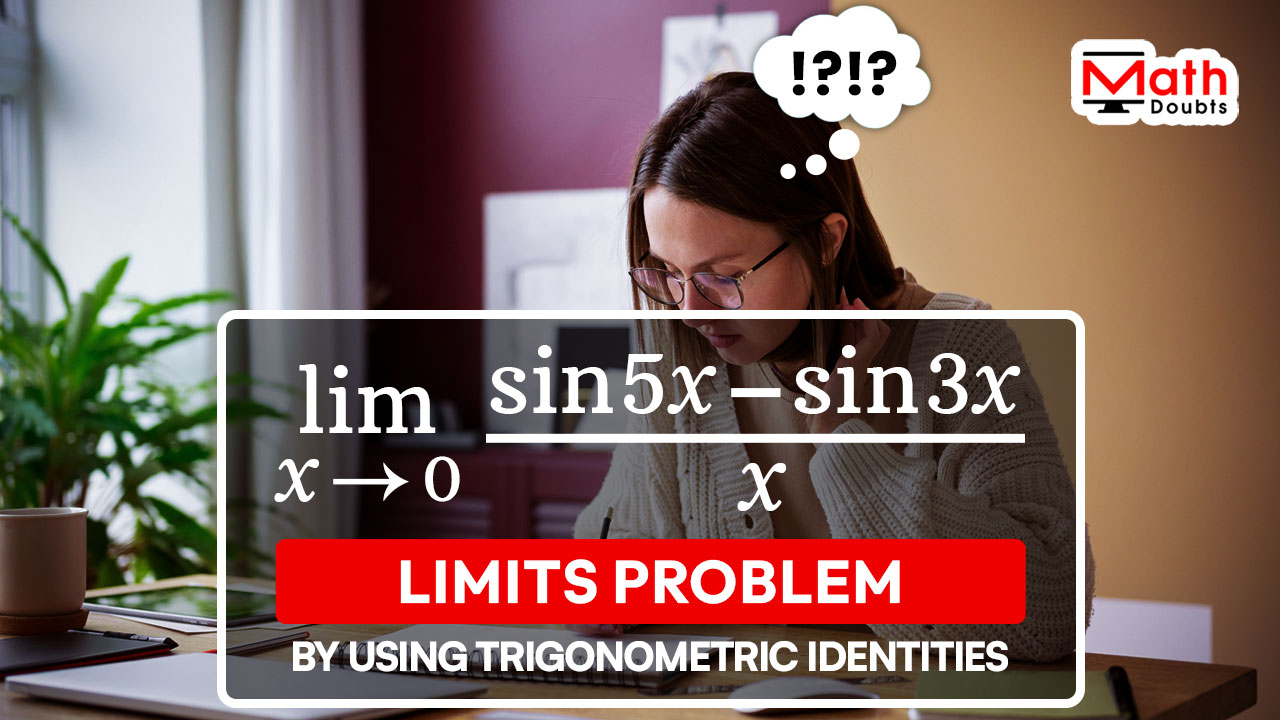The limit of sine of angle five times $x$ minus sine of angle three times $x$ divided by $x$ as the value of variable $x$ approaches zero is indeterminate as per the limit by direct substitution method.
$\displaystyle \large \lim_{x\,\to\,0}{\normalsize \dfrac{\sin{5x}-\sin{3x}}{x}}$ $\,=\,$ $\dfrac{0}{0}$
However, the limit of $\sin{5x}$ minus $\sin{3x}$ divided by $x$ as $x$ tends to $0$ can be evaluated by using the trigonometric identities and let’s learn how to find its limit.

The difference between two sine functions in the numerator, and a variable in the denominator are the main reason for the indeterminate form. The expressions should be converted into other form if possible. So, let us try to convert the expressions in both numerator and denominators into other form.
The difference between sine functions can be transformed into product form of the trigonometric functions as per the difference to product trigonometric identity in sine functions.
$=\,\,$ $\displaystyle \large \lim_{x\,\to\,0}{\normalsize \dfrac{2\cos{\bigg(\dfrac{5x+3x}{2}\bigg)}\sin{\bigg(\dfrac{5x-3x}{2}\bigg)}}{x}}$
The expression in the denominator is a variable and it cannot be transformed into other form. So, let’s leave it as it is.
Now, let’s focus on simplifying the expressions in numerator and denominator of the rational function.
There are two trigonometric functions as factors in numerator and each trigonometric function has a function internally. So, the function inside every trigonometric function in the numerator should be simplified further to obtain the whole function in simplified form.
$=\,\,$ $\displaystyle \large \lim_{x\,\to\,0}{\normalsize \dfrac{2\cos{\bigg(\dfrac{8x}{2}\bigg)}\sin{\bigg(\dfrac{2x}{2}\bigg)}}{x}}$
$=\,\,$ $\displaystyle \large \lim_{x\,\to\,0}{\normalsize \dfrac{2\cos{\bigg(\dfrac{\cancel{8}x}{\cancel{2}}\bigg)}\sin{\bigg(\dfrac{\cancel{2}x}{\cancel{2}}\bigg)}}{x}}$
$=\,\,$ $\displaystyle \large \lim_{x\,\to\,0}{\normalsize \dfrac{2\cos{(4x)}\sin{(x)}}{x}}$
$=\,\,$ $\displaystyle \large \lim_{x\,\to\,0}{\normalsize \dfrac{2\cos{4x}\sin{x}}{x}}$
The expressions in both numerator and denominator are now in simplified form and it clears that the whole rational function is in simplified form. Now, the limit of the function in rational form can be evaluated as the value of $x$ tends to zero.
The limit of the above simplified rational function remains indeterminate if you try to find the limit by the direct substitution method. It is because of the sine function in numerator and the variable $x$ in the denominator. If the functions that cause indeterminate form are excluded from the whole rational function, then there is a possibility to find the limit of the function.
Let’s try to eliminate the sine function and variable $x$ from the rational function and it is possible when the rational function is split as two factors.
$=\,\,$ $\displaystyle \large \lim_{x\,\to\,0}{\normalsize \dfrac{2\cos{4x} \times \sin{x}}{x}}$
Now, let’s split the whole rational function as a product of two factors by the product rule of the fractions.
$=\,\,$ $\displaystyle \large \lim_{x\,\to\,0}{\normalsize \bigg(2\cos{4x} \times \dfrac{\sin{x}}{x}\bigg)}$
Let’s use the product rule of the limits to find the product of two functions by the product of their limits.
$=\,\,$ $\displaystyle \large \lim_{x\,\to\,0}{\normalsize 2\cos{4x}}$ $\times$ $\displaystyle \large \lim_{x\,\to\,0}{\normalsize \dfrac{\sin{x}}{x}}$
Now, let’s find the limit of each function as the value of $x$ is closer to zero.
Use the direction substitution method and let’s find the limit in the first factor position.
$=\,\,$ $2\cos{4(0)}$ $\times$ $\displaystyle \large \lim_{x\,\to\,0}{\normalsize \dfrac{\sin{x}}{x}}$
$=\,\,$ $2\cos{(4 \times 0)}$ $\times$ $\displaystyle \large \lim_{x\,\to\,0}{\normalsize \dfrac{\sin{x}}{x}}$
$=\,\,$ $2\cos{(0)}$ $\times$ $\displaystyle \large \lim_{x\,\to\,0}{\normalsize \dfrac{\sin{x}}{x}}$
$=\,\,$ $2\cos{0}$ $\times$ $\displaystyle \large \lim_{x\,\to\,0}{\normalsize \dfrac{\sin{x}}{x}}$
$=\,\,$ $2 \times \cos{0}$ $\times$ $\displaystyle \large \lim_{x\,\to\,0}{\normalsize \dfrac{\sin{x}}{x}}$
The cos of zero radian is one as per the trigonometry. Now, substitute it in the function.
$=\,\,$ $2 \times 1$ $\times$ $\displaystyle \large \lim_{x\,\to\,0}{\normalsize \dfrac{\sin{x}}{x}}$
$=\,\,$ $2$ $\times$ $\displaystyle \large \lim_{x\,\to\,0}{\normalsize \dfrac{\sin{x}}{x}}$
Similarly, let’s find the limit of the remaining rational function in the second factor position.
$=\,\,$ $2$ $\times$ $\displaystyle \large \lim_{x\,\to\,0}{\normalsize \dfrac{\sin{x}}{x}}$
The second factor express a trigonometric limit rule in sine function. Therefore, the limit of sine of angle $x$ divided $x$ as $x$ approaches to zero is equal to one.
$=\,\,\,$ $2 \times 1$
$=\,\,\,$ $2$
The limit can also be evaluated in the following two methods.
A free math education service for students to learn every math concept easily, for teachers to teach mathematics understandably and for mathematicians to share their maths researching projects.
Copyright © 2012 - 2025 Math Doubts, All Rights Reserved